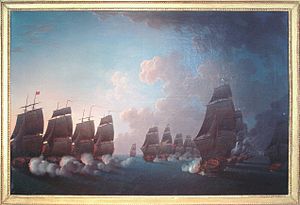- Battle of Martinique (1780)
-
For the 1779 encounter, see Battle of Martinique (1779).
Battle of Martinique Part of the American War of Independence 
Combat de la Dominique, 17 Avril 1780, by Auguste Louis de Rossel de Cercy (1736-1804).Date April 17, 1780 Location Off Martinique, West Indies Result Indecisive[1][2][3] Belligerents  Great Britain
Great Britain France
FranceCommanders and leaders Sir George Rodney Comte de Guichen Strength 20 ships of the line 23 ships of the line Casualties and losses 120 killed, 354 wounded 222 killed, 537 wounded - 1st Nassau
- Barbados
- Dominica
- 1st St. Lucia
- 2nd St. Lucia
- Saint Vincent
- 1st Grenada
- 2nd Grenada
- 1st Martinique
- 2nd Martinique
- Dutch West Indies
- Sint Eustatius
- Fort Royal
- Tobago
- Brimstone Hill
- Frigate Bay
- Demerara and Essequibo
- Montserrat
- The Saintes
- Mona Passage
- 2nd Nassau
- 18 October 1782
- 6 December 1782
- 3rd Nassau
- Turks and Caicos
The Battle of Martinique, also Combat de la Dominique, took place on April 17, 1780 during the American War of Independence in the West Indies between the British Royal Navy and the French Navy.
Contents
Origins
In January 1780 the Comte de Guichen was sent to the French base at Martinique in the West Indies with a strong squadron. He was opposed by British admiral Sir George Rodney, who reached the British base at St. Lucia in late March.
Guichen sailed from Martinique on April 13, 1780, with a fleet of 23 ships of the line and 3,000 troops. His objective was to draw Rodney out, but then to escape him and make an attack on either St. Lucia or the British base at Barbados. Rodney sailed out at once upon being informed that Guichen had sailed. On April 16, his sentinels spotted Guichen on the leeward side of Martinique, beating against the wind. Rodney gave chase, but was unable to close in time for battle that day. Rodney managed to maintain contact with Guichen and hold his line that night.
Battle
The fleets began maneuvering for the advantage of the weather gage on the morning of April 17. By 8:45 Rodney had successfully reached a position to the windward of Guichen, in a relatively close formation. To escape the danger to his rear, Guichen ordered his line to wear and sail to the north, stringing out the line in the process. This forced Rodney to go through another series of maneuvers to regain his position, which he did by late morning. At this point he hoped to engage the rear and center of Guichen's elongated line, concentrating his power to maximize damage there before Guichen's van could join the action. The signal that Rodney issued was for each ship to engage the appropriate ship it was paired with according to the disposition of the two fleets. He issued this signal with the understanding that his captains would execute it in the context of signals given earlier in the day that the enemy's rear was the target of the attack.
Unfortunately, Robert Carkett, commander of HMS Stirling Castle, the lead ship, either misunderstood the signal or had forgotten the earlier one, and moved ahead to engage Guichen's van; he was followed by the rest of Rodney's fleet, and the two lines ended up engaging ship to ship.
Thanks to the orderly fashion in which De Guichen's subordinate squadron-commanders dealt with the crisis, especially the third-in-command Comte de Grasse's rapid closing-up of the battle-line, Guichen managed to extricate himself from a difficult situation and, instead turn a narrow defeat to a drawn battle, although his and Marquis de Bouillé's objective to attack and seize Jamaica were cancelled.
During the battle, both Rodney's Sandwich and Guichen's Couronne were temporarily cut off from their respective fleets and bore the brunt of the battle.
Aftermath
Rodney felt that the failure to properly attack the French rear cost the British an opportunity for a significant victory, and assessed blame to Carkett and others who did not properly follow his signals. Others assigned the blame to Rodney, for failing to inform his captains in advance of his intended tactics.
Both fleets avoided further action prior to the hurricane season. Guichen returned to France with many of his damaged ships in August, and Rodney sailed for New York.
Order of battle
 A French ship of the line at the Battle of Martinique
A French ship of the line at the Battle of Martinique
Incomplete order of battle
- Pluton
- Sphinx
References
- Jaques, Tony (2007) Dictionary of Battles and Sieges: F-O. Westport: Greenwood Publishing Group ISBN 9780313335389
- Sweetman, Jack (1997) The great admirals: command at sea, 1587-1945. Annapolis: Naval Institute Press ISBN 9780870212291
- Botta, Carlo (1813) Histoire de la guerre de l'indépendance des Et́ats-Unis d'Ameŕique, Volumen 4. Paris: J.G. Dentu
- Palmer, Michael. Command at sea: naval command and control since the sixteenth century
Categories:- Conflicts in 1780
- Naval battles of the American Revolutionary War
- Naval battles involving France
- Naval battles involving Great Britain
- History of Martinique
- 1780 in France
Wikimedia Foundation. 2010.
